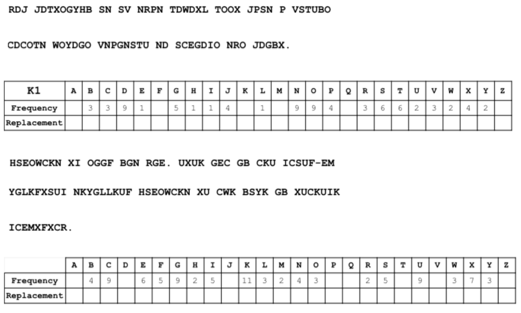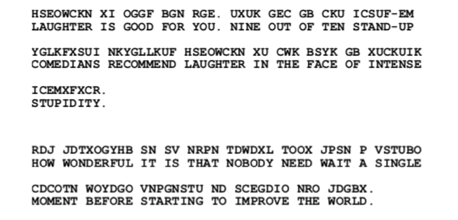Syllogism – Ciphers are fun; ciphers are fun. Therefore, ciphers are fun.
If some of you nerds did Science Olympiad, you likely know of the event Codebusters. However, some of you non-Science Olympians may not be familiar it. Here’s the likely unexpected overview of the event: you bust codes*. Yes yes, stay in your seats, ladies and gentlemen.
*Technically a code is an encryption where a word is given a new meaning, while a cipher is an encryption where a letter is given a new meaning. For this article we’re going to use code as an all-encompassing term.
The event involves cracking various types of codes, but the most prevalent is the mono-alphabetic simple substitution cipher. As the name suggests, each letter in the alphabet is substituted with another letter. Very straightforward. Example code is shown below.

If you happen to find yourself lacking something to do and aren’t in the mood to watch Netflix, try breaking some codes! They have a wide range in difficulty, so do not worry if you’re not considered pro status.
How does one go about solving these jumbles of letters???
Well, the primary thing to look for is word patterns. The first four words I look for are the, that, a, and I. A and I are typically the only letters that can be by themselves, so they easy to spot. Plus, they’re common vowels, so once you can fill them in, you are much on your way to breaking the rest of the code. The is a great word to look for because it’s so common. Repetition of a three letter word throughout a code should make your mind immediately consider substituting the. That is a great one because it starts and ends with the same letter. Plus, take b as t, if you’re looking over a code and see b frequently, including at the start and end of a four letter word, you can make a solid guess the word is that. (T is the second most common letter, so when you see b frequently here, you figure hmm t is likely quite frequent here.)
It’s also a good idea to look for apostrophes. The vast majority of the time, the letter after the apostrophe is s or t. And, another point of note is the importance of making guesses. Guard against staring and staring at a code, unwilling to make a reasonable guess for fear of having to use your eraser.
I encourage you to go find yourself some codes. Try searching the web for some practice mono-alphabetic substitution ciphers. Also check out the site cryptograms.org. Note: I think breaking codes is much more satisfying when solving them physically on paper, but it’s still fun to solve them on a screen.
If you read this article and think ha!, this writer is a fool, she is failing to properly educate aspiring codebusters, please tone down your judgement a little. I am most likely a fool, but in this instance it’s possible I would be awarded more of a fool characterization than is deserved. I am aware that some exceptions in term of cipher form exist. This article is merely meant to provide a basic overview.
Those with questions or statements of some kind on all things code, feel free to leave a comment.
Appendix-ish Here are a couple codes to try cracking. As labeled, the tables simply show letter frequency within the cipher text (!), not within the cracked code. Letters e t a o i n are the most commonly used in English. When you see, in the code below, that D is the most frequent letter, it’s reasonable to think hmm, this is quite possibly e, t, a, o, i, or n.
I don’t know if I’m able to post a whole document to this post, so I just attached pictures of the codes. If your heart desires, just save them as pictures, then print them. #IThinkItIsFunToUseThePrintersHere.

NOTE THE ANSWERS TO THE TWO ABOVE CODES ARE LISTED BELOW.
